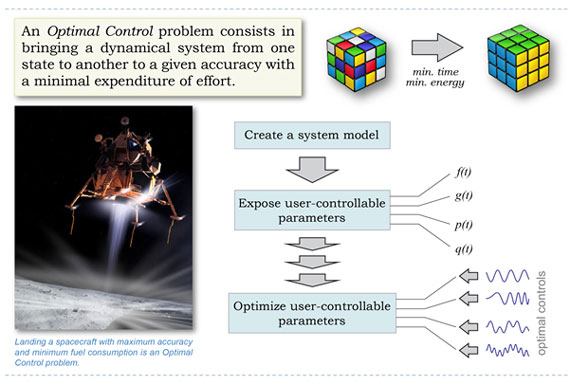| Sep 06, 2013 |
Optimal control of quantum systems
|
|
(Nanowerk News) It is control that turns scientific knowledge into useful technology – control over aerodynamic processes allows a pilot to land an aircraft, and control over the structure of atomic layers on a silicon wafer underpins semiconductor engineering.
|
|
Control is what puts a human into the driver’s seat – we use it to manage production lines, optimize the flow of traffic, maintain the temperature in office buildings, and generally to make things work.
|
|
Control also allows us to maximize efficiency and minimize resource consumption: the optimal control theory in physics and engineering is about getting a particular system from one state to another with minimal expenditure of energy and resources.
|
|
Originally developed in the 1960s to facilitate engineering work and famously applied to find optimal trajectories to reach the moon by the Apollo missions, optimal control theory has evolved and expanded with the rest of physics – it is presently found in areas as diverse as optical spectroscopy, photochemistry, magnetic resonance and quantum information processing.
|
 |
| Optimal Control - an illustrative explanation.
|
|
The natural world is fundamentally quantum mechanical and, of the many currently investigated phenomena, quantum effects in particular are very attractive as a source of new technologies: they play a defining role in molecular physics, single-photon optics, chemistry, superconductors, semiconductors, electronics, spintronics, etc.
|
|
At this point in human technological history quantum effects are no longer some exotic phenomena that one could ignore, but are crucial from a technological point of view – the first quantum revolution produced semiconductors and lasers which are used virtually everywhere today (computers, mobile phones, DVD drives, etc.), and more recently, digital cameras (photoelectric effect), magnetic resonance imaging (spin dynamics), quantum cryptography (photonics) and large-capacity computer disks (giant magnetoresistance) have been bringing about dramatic leaps in consumer space, information technology and general community welfare.
|
|
Device miniaturization has progressed so far that a transistor gate on a modern chip is less than 300 atoms wide, and that miniaturization process is coming to an end – we will soon get down to single atoms that behave 100% quantum mechanically. Fittingly, the 2012 Nobel Prize in Physics was awarded for “ground-breaking experimental methods that enable measuring and manipulation of individual quantum systems” summarized as “particle control in a quantum world” in the Swedish Royal Academy of Sciences press release.
|
|
The first applications of optimal control theory to the realm of quantum mechanics were reported in the 1980s, dealing with the design of shaped laser and radio-frequency pulses to manipulate chemical reactions and spin systems. More generally, the field of quantum optimal control is a part of the current effort to re-engineer industrial and scientific technologies from the bottom up – we are learning to control single particles and molecules and, on the way, powerful tools are being developed to improve existing technologies: atomic-scale defects in diamonds were recently used as super-sensitive magnetic sensors and a better understanding of photosynthesis was used to improve the design of solar cells. Future quantum-enabled technologies will be based on exploiting even more elusive yet very powerful resources – quantum interference and entanglement.
|
|
A physical process realized by creating interference and entanglement with external controls, such as magnetic or laser fields, would need to be controlled with extraordinary precision and high speed: we must be able to accurately and deliberately steer individual quantum systems, while isolating them from all sources of unwanted noise. To do so under the incredibly tough conditions imposed by instrumental sensitivity, power, timing and accuracy is the goal of quantum optimal control.
|
|
QUAINT
|
|
The QUAINT Consortium, formed in 2012, is a pan-European Coordination Action on Optimal Control of Quantum Systems, funded through European Framework Programme 7.
|
|
QUAINT seeks to bring together all major European and Israeli research centres in Optimal Control of Quantum Systems.
|
|
The project coordinates scientific activities, research publications, personnel training and public engagement in 17 established research groups from 15 universities in 6 countries – a total of about 60 scientists and 30 PhD students, spanning a variety of nationalities, races, cultures, social backgrounds, genders and career stages. The Consortium is co-ordinated by Dr Ilya Kuprov at the University of Southampton and involves colleagues from the Ecole Polytechnique and the University of Bourgogne in France; the universities of Ulm, Munich, Kassel, Karlsruhe and Saarland in Germany; the universities of Nottingham, Cardiff, Swansea and Southampton in the UK; the Hebrew University and the Weizmann Institute in Israel; the Aarhus University in Denmark; and the Charles University in the Czech Republic.
|
|
The Consortium unites the forces of multiple EU and Israeli research groups to explore a radical expansion of the currently established technologies – quantum technologies, where bits are carried by atoms or elementary particles and dramatic improvement is believed to be possible for several types of technological processes. Our specific research area within Quantum Technology is optimal control of quantum systems – a set of methods that enable extremely accurate manipulation of quantum systems with minimal expenditure of energy.
|
|
Within this Coordination Action, QUAINT aims to create a vibrant, productive and efficient European research community, to deliver value to the society and to grow a new generation of young European physicists.
|

